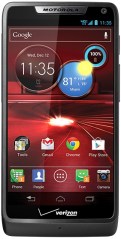With the exception of Apple’s iPhone, the smartphone market has been dominated lately by the idea that bigger is better. If you want a top-of-the-line Android smartphone, you’re practically forced to have a screen that measures at least 4.7 inches diagonally.
There’s nothing wrong with humongous smartphone screens. Some people enjoy having more real estate, even if it requires straining for one-handed use or taking up all the room in your pants pocket. But one size doesn’t fit all, and with so many high-end phones opting for massive screens, our choices in hardware actually seem to be diminishing.
(MORE: Motorola Bringing Three New Razr Smartphones to Verizon)
So I’m glad to see Motorola at least considering a comeback for smaller phones that don’t skimp on specs. “Just because one’s slightly larger than another, it shouldn’t mean that it’s better, powerful and it’s got all the good things,” Rick Osterloh, senior vice president of Google’s Motorola Mobility, said in an interview. “They should both be awesome.”
Motorola’s Droid Razr M, which launched in September on Verizon Wireless, is a step in that direction. The phone has a 4.3-inch display, but it actually feels a bit smaller than other phones of similar size. That’s partly because of the narrow bezel around the sides of the screen, and partly because the software buttons are part of the screen itself. The Razr M is roughly the same height and width as Apple’s iPhone 5, though the Razr’s screen is a bit wider (and taller if you count the area occupied by the software buttons).

Motorola
Osterloh insists that the Razr M is a high-end phone, but it does have a couple of compromises compared to Motorola’s upcoming Droid Razr HD and Razr HD Maxx, which both have 4.7-inch displays. Although all three phones have 1.5 GHz dual-core processors, 8-megapixel cameras, the same image sensor and 1 GB of RAM, the Razr M only has 8 GB of internal storage, compared to 16 GB in the Razr HD and 32 GB in the Razr Maxx HD. If you want more storage, you’ll need to pop in a MicroSD card.
(MORE: Motorola Atrix HD Review: The Mid-Range Gets Good)
Also, with a screen resolution of 960-by-540, the Razr M has a lower pixel density than the 1280-by-720 display on the Razr HD. This wouldn’t be a major drawback if Motorola didn’t use a PenTile subpixel arrangement, which makes text look a bit fuzzy, especially on the lower-resolution display. Even on solid backgrounds, you can sometimes see the the tiny dots that make up the display. For $100 on-contract, the Razr M is a fine mid-range device, but it’s not quite on the level of the iPhone or high-end Android handsets.
I’m hoping Motorola keeps working on smaller phones with fewer compromises. The company at least seems interested in doing so. “I can’t speak for other people, but for us, we think there’s a real market there,” Osterloh said. “We think this is a great place to be.”
Still, don’t expect Motorola to lose interest in smartphones with gigantic screens. Osterloh argued that the rise of 4G LTE networks and the continued expansion of mobile apps have both fed into a desire for larger displays.
“It’s like all of a sudden, having a bigger phone is incredibly useful because you can actually use the things that require a bigger screen,” he said. “You can do e-mail faster, you can browse faster, you can download a movie and watch it. It’s crossed over to a point where carrying a slightly larger form can be convenient for people who want to do more on the go.”

